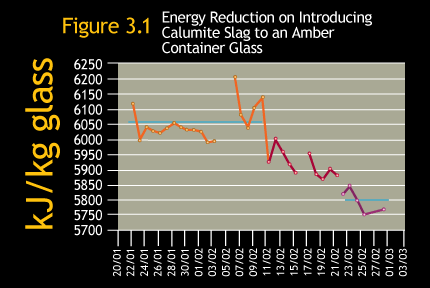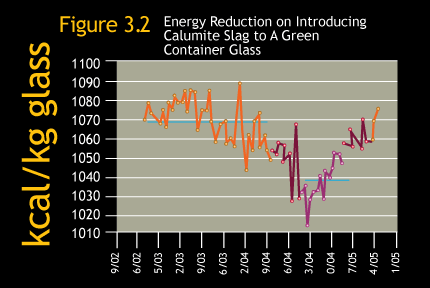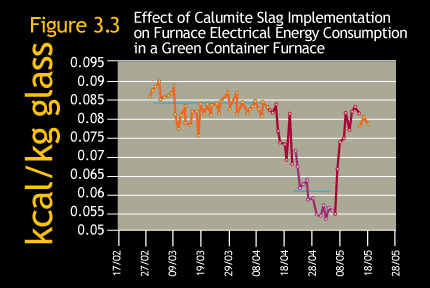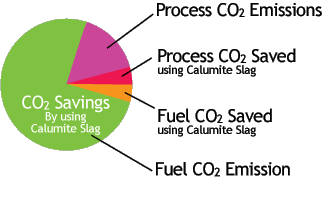Reduced Specific Energy Consumption
The glassy nature of Calumite Slag , combined with its chemical composition, leads to faster melting. As a result, the energy required to
melt the glass, while maintaining existing furnace temperatures, is actually lower. Depending on the specific furnace design and control parameters,
this can be used to reduce the total energy consumption/ton of glass, or specifically to reduce the use of electric boost.
The following graphs illustrate examples where the use of Calumite Slag has reduced the specific energy consumption. In all examples,
the data are separated according to the three stages; without Calumite Slag , while Calumite Slag is being introduced, and with Calumite Slag in the
batch. The savings quoted are based on the average values before and after the introduction of Calumite Slag .
Introducing Calumite Slag to the amber container glass, figure 3.1, led to a 4.2% reduction in the overall energy consumption/ton of glass,
which was maintained with the continued use of Calumite Slag in the batch.
The introduction of Calumite Slag for a trial period in a green container furnace, figure 3.2, showed an average reduction of 3% of the
total energy consumption over the trial period. The maximum energy reduction was 5%, which was achieved in conjunction with furnace
temperature reductions and glass quality improvements.



Reduced Furnace Electrical Consumption
The faster melting with Calumite Slag often leads to a direct increase in furnace bottom temperatures. This can be used specifically to
reduce the power to the electric boost system and hence reduce the electrical energy consumption. This is illustrated with the following
example from a green container furnace with 13% Calumite Slag , when the electrical energy consumption was reduced by over 30%. Despite this
significant reduction in energy consumption, the bottom temperatures were on average 10°C hotter during the trial period than when Calumite
slag was not in use, indicating potential for further energy reduction.


Increasing Calumite Slag Usage
For existing users of Calumite Slag , it is worth noting that increasing the level of Calumite Slag used in the batch would be expected to offer
similar energy savings, whether in terms of total energy consumption or specific electrical energy reduction. For example, increasing from
6% to 12% in a green container furnace would be expected to reduce specific energy consumption by 1.5% - 2%.
Energy Savings
In the current climate of increasing energy prices, the value of Calumite Slag as a means of reducing energy consumption is increasingly being
recognized. Use of Calumite Slag has been proven to reduce energy consumption in all types of soda-lime-silica glass production, including cosmetic
flint, float, and fiber glass.
The level of energy savings achieved will be dependent on the specific furnace, along with factors such as glass color and cullet level.
However the regular use of Calumite Slag will reduce overall energy consumption by 4-5%.
The average energy saving through the use of cullet is typically 2.5% energy reduction per 10% cullet increase. Therefore, the use of Calumite Slag
can lead to savings equivalent to increasing the cullet level by up to 12-16%.
Increased Glass Yield
The use of Calumite Slag results in more glass produced per ton of batch melted, as there are no products of decomposition produced as Calumite Slag
reacts in the batch. The increased yield varies from 1.3% in flint glass to 3.2% when Calumite Slag is used in amber glass.
Increased Furnace Pull
The faster melting with Calumite Slag can lead to increased furnace pull, without the need to increase furnace temperatures or specific energy
consumption. In a number of cases, with the introduction of Calumite Slag , furnace pull has been increased beyond the design output of the furnace and
beyond the previous maximum pull that had been achieved. Increased production beyond this previous maximum results in extra financial contribution
on all additional tonnage.
Improved Glass Quality
Calumite Slag reduces seeds in the glass by over 50% on average. It also reduces the tendency for blister and batch stones
that are often rejected by inspection equipment. A modest 0.25% reduction in scanner rejects for a plant manufacturing 600 tons per day of glass
would allow an additional 150m2/day of float glass at 4 mm or 7,500 containers per day at an average of 200g to be packed.
Increased Furnace Life
A typical furnace rebuild costs approximately $14,000,000. Therefore, an extension of campaign life of just four months through the lowering of furnace
temperatures using Calumite Slag would offer significant cost advantages.
Batch Simplification
Use of Calumite Slag can potentially result in simplification of a batch recipe due to the range of oxides that it contains. In many cases, Calumite Slag
is used as the sole alumina source. If this advantage can be considered during the design stage of a glass plant, then huge capital sums can be saved
if the batch plant design can be simplified to accommodate fewer raw materials.
Reduced SOx Emissions
Utilizing Calumite slag allows for reduction in the saltcake required to refine the glass.
Lower SOx emissions can avoid the use of SOx removal from furnace exhaust gasses or reduce the operating cost of any that is installed.
Assists in the production of stable Amber glasses, with less seed and blister defects and more production within the target color range
Reduced CO2 Emissions
Calumite Slag reduces both the process CO2 emissions
through the partial replacement of limestone and dolomite, and CO2 emissions from fuel due to reduced energy consumption.

Reduced Pr?cess CO2
For an amber furnace at 250tpd, 50% cullet, the 18% reduction in process CO2 offers an annual reduction of over 1500 tons.
For a flint container operating at 250tpd, 40% cullet, the annual reduction in process CO2 is over 800 tons.
Reduced CO2 from Combustion
A 3% reduction in energy would equate to 3332MWh/annum. Given that 180 kg CO2 is emitted on combustion of 1MWh, this results in
total annual CO2 reduction of 600 tons.
Reduced NOx
The implementation of Calumite Slag can reduce furnace crown temperatures by 30°C, reducing thermal NOx by 10%. When used in conjunction
with other primary NOx reduction techniques, this could negate the need for expensive NOx abatement technology.